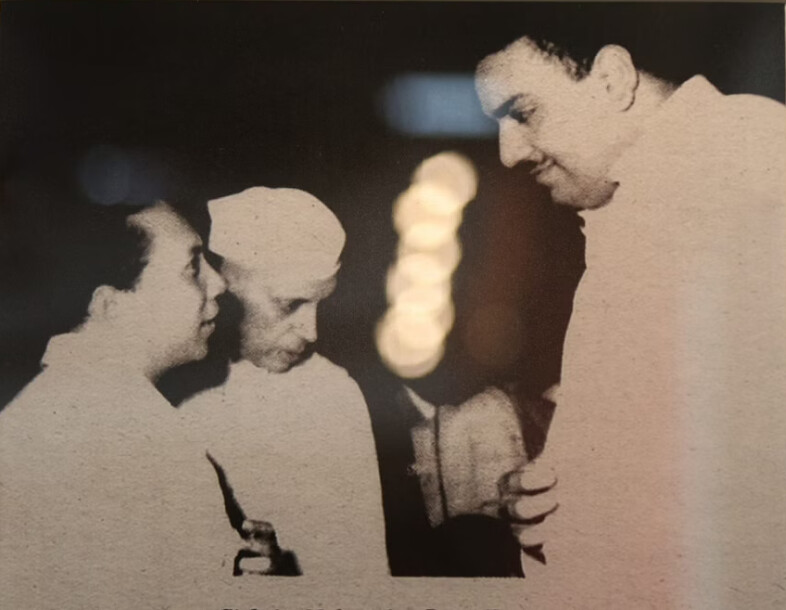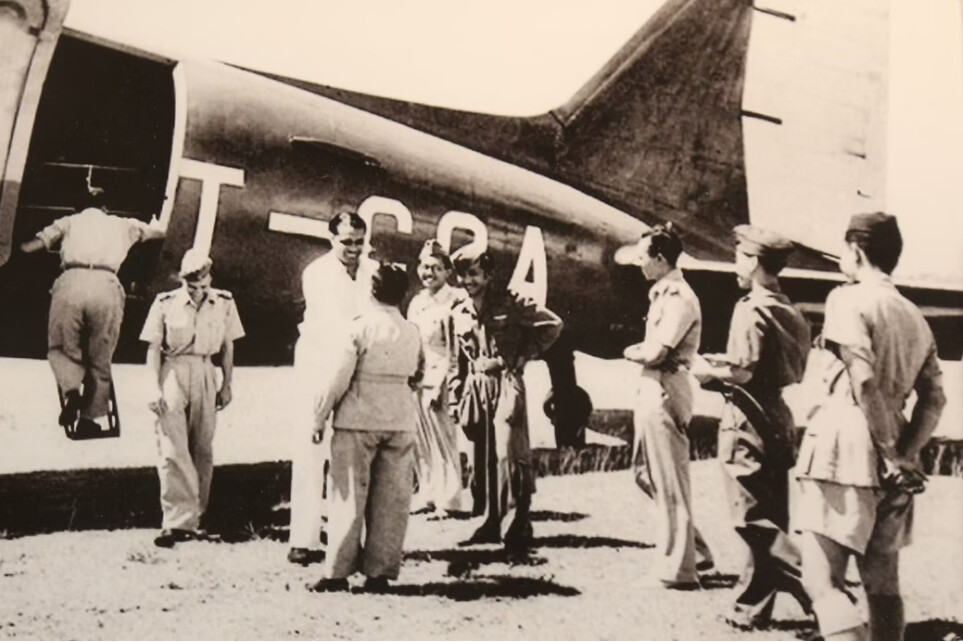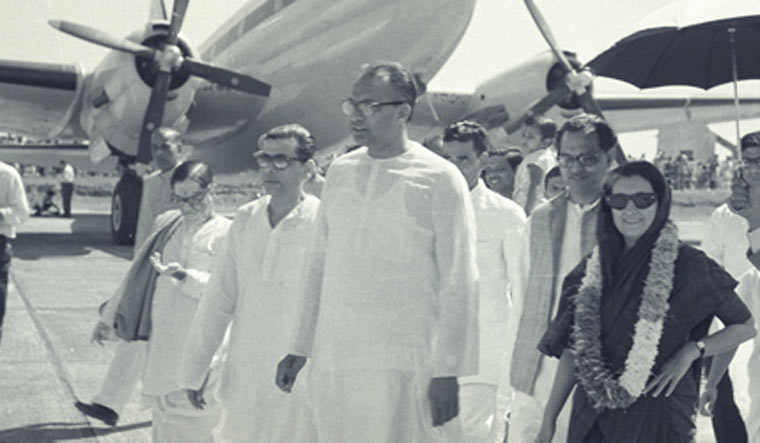At the Indonesian Embassy in Chanakyapuri, New Delhi, there is a room named after aviator, entrepreneur, freedom fighter and former Odisha chief minister Bijayananda (Biju) Patnaik.
A highly skilled pilot with the Royal Indian Air Force, Biju Patnaik flew a series of high-risk missions in 1947 to transport top Indonesian resistance leaders, including president Sukarno, vice-president Mohammad Hatta and prime minister Sutan Sjahrir away from the prying eyes of Dutch colonists looking to recolonise the country after World War II.
Along the walls of this special room in the Indonesian Embassy are letters, photographs, and newspaper clippings documenting his secret missions and relationship with the Indonesian leadership.
His story ranks among the most remarkable ones in recent Indian political history.
Top Gun
Born on 5 March 1916 in Cuttack, Odisha, Biju grew up in relative comfort with his father Laxminarayan employed with the judicial service. Despite serving in the colonial administration, Laxminarayan was heavily involved in the Oriya Movement and maintained close ties with freedom fighters from his state like Gopabandhu Das and Madhusudhan Das.
There were two events in Biju’s life that would shape his journey in life moving forward.
Barely 11, he got his first taste of the freedom struggle. In 1927, he saw Mahatma Gandhi for the first time. Gandhi was on his ‘Khadi Tour’ in Cuttack, when a young Biju was assaulted by a British police officer for trying to catch a glimpse of the freedom fighter.
Another seminal moment in his life arrived when, as a school student studying at the Mission School in Cuttack, he saw a small aeroplane landing at the city’s Killa Fort.
“At that time I had only seen pictures of aeroplanes in books,” he recalled. He had always been fascinated by aeroplanes in school and this was his chance to actually see and touch one.
In that anecdote, he went on to add that he ran away from school to touch his dream object, following which the police stationed there chased him away.
Following his school, he went to university but dropped out to undergo training as a pilot at the Aeronautic Training Institute of India and Delhi Flying Club. When World War II began, Biju joined the Royal Indian Air Force. His exploits as a pilot during World War II remain legendary.
According to an obituary published in The Independent on 1 May 1997, “As an officer in the Royal Indian Air Force in the early 1940s, Patnaik flew innumerable sorties to rescue British families fleeing the Japanese advance on Rangoon, the capital of Burma. He also dropped arms and supplies to Chinese troops fighting the Japanese and later to the Soviet army struggling against Hitler’s onslaught near Stalingrad. Two years ago, on the 50th anniversary of the end of the war, Patnaik was honoured by the Russians for his help.”
While Biju understood his duties as a pilot for the Allied Forces in World War II, he was also under the spell of Mahatma Gandhi and his passive resistance to British rule.
According to Dr Pabak Kanungo, a noted writer and Gandhian scholar, “While flying over Indian soldiers under the British Command, he dropped bags of Gandhi’s ‘Quit India’ leaflets to them. But though he served the British, Biju Patnaik’s loyalty was with the Indian freedom struggle.”
“While on leave, he ferried freedom fighters to secret meetings with their supporters. As head of the Air Transport Command, he sheltered prominent fighters like Jaya Prakash Narayan, Ram Manohar Lohia and Aruna Asaf Ali. While flying the British to safety from Yangon, he also air-dropped leaflets supporting the cause of Netaji’s Indian National Army,” he added.
As Biju recalled, “When the British authority found out, they nearly got me shot for subversive activities. That was the time I was put behind bars during the Quit India Movement.”
He was arrested on 13 January 1943 and sentenced to two years in prison for his actions.
Following his release, Biju was employed as a pilot by the Indian National Airways, a private venture set up by Delhi-based industrialist Raymond Eustace Grant Govan. Even during his stint as a pilot for the airlines, he continued to lend his services to freedom fighters.
In fact, there is an Intelligence Bureau note dated 29 September 1945, which claims that Biju “misused” his position as pilot by “surreptitiously flying [Ram Manohar] Lohia (who was at the time underground) from Delhi to Calcutta”.
Remembering Biju Babu on his Jayanti. This document from the pages of history (dated 1945) gives a glimpse of his courage (flying Dr. Lohia, who was then underground) and excellence.
— Narendra Modi (@narendramodi) March 5, 2020
Biju Babu worked tirelessly for India’s progress and pioneered the development of Odisha. pic.twitter.com/XLEjzOFEiQ
The note goes on to state, “It can be argued that Patnaik may still be a danger so long as conditions on our Eastern border do not return to normal — but that would be to state a very hypothetical risk. In the circumstances, we do not feel that we can urge, on strong security grounds, that Patnaik should be prevented from flying.”
However, the IB came to the conclusion that flying is his “normal way of making a living” and that if they even prevailed upon the Indian National Airways to not employ him, the Tatas would. In the following year, he was elected to the Orissa Assembly from the North Cuttack constituency and also started his first major business venture, Kalinga Tubes, at Choudwar.
At one time, Kalinga Tubes was among Asia’s largest pipe manufacturing plants. But as he once said, “Flying is my first love and though it has dimmed with age, it still remains so.”

Bhoomi Putra
After Japan’s formal surrender during World War II, they withdrew from the countries they had occupied in Southeast Asia, including Indonesia. Following this development, Indonesia declared independence on 17 August 1945 with Sukarno elected president and Sjahrir as prime minister.
However, the Dutch, who had previously colonised Indonesia before World War II, rejected this declaration. What followed was a period of military hostilities and negotiations between the Indonesian resistance fighters and the Dutch and British colonial armies.
Given the toll that World War II had taken on the British, they bowed out of this conflict early but offered to mediate between the remaining two sides — an offer which was rejected.
Jawaharlal Nehru, prime minister of the interim government of India, was angered by the Dutch government’s attempts at recolonising Indonesia. Globally, he had aggressively campaigned for the freedom of many countries under the yoke of European colonialism, particularly those in Asia. The first major step he took in this regard was to organise the Asia Relations Conference in March-April 1947 in New Delhi to discuss the situation in Indonesia.
Nehru also sent Biju to conduct risky air sorties to assist the Indonesian resistance as well.
According to a report in The Hindu by Suhasini Haider, “Biju Patnaik’s missions involved flying in undetected to Yogjakarta where the ‘resistance’ Republican leadership led by Sukarno was based when Dutch forces launched ‘Operation Product’ on July 20, 1947 to capture the capital Jakarta. At Prime Minister Jawaharlal Nehru’s request, Patnaik, who had earlier served in the British Royal Air Force (RAF) and then joined the freedom movement, agreed to fly one of his Dakota planes into Indonesia, eluding Dutch air surveillance.”

However, there is one mission which someone could perhaps make a movie out of one day.
Biju was tasked with transporting Indonesian PM Sutan Sjahrir and vice-president Mohammad Hatta out of Indonesia to India for secret talks with Nehru and Sardar Vallabhai Patel in New Delhi.
As Dr Kanungo wrote, “In what can be aptly described as a drama in real life, Biju took off in an old fashioned Dakota with wife Gyan for Jakarta (leaving behind their 14-day-old son), where the rebel’s headquarters was located. In Singapore, he received a message from the Dutch threatening to shoot down his aircraft if it entered Indonesian airspace.”
In response, Biju allegedly said with backing from Nehru, “Resurgent India does not recognise Dutch colonial sovereignty over the Indonesian people. If my aircraft is shot down, every Dutch plane flying across the Indian skies will be shot down in retaliation.”
The ace pilot somehow landed his plane on an improvised air strip near Jakarta. To refuel his plane, he used up whatever petrol was left behind from abandoned Japanese military dumps and transported them to New Delhi via Singapore.
There is another such incident memorialised at the room in the Indonesian Embassy. On another sortie, he had a narrow escape when Dutch Mustang planes bombed the airfiled where his plane had landed. Coming to his rescue was an engineer, who hid the plane. On the following day, he was caught in another air raid at an oil dump and “had to run 300 yards for cover as the Dutch [planes] strafed it.”
Eventually, on 27 December 1949, Indonesia formally achieved its independence from the Netherlands.
For his contribution to the cause, Biju was awarded the Bhoomi Putra (Son of the Soil), the nation’s highest civilian award, in 1950. As an interesting aside, president Sukarno named his daughter Megawati Sukarnoputri following Biju’s recommendation. Megawati would go on to become the fifth president of Indonesia (2001-2004).
Despite seeing so much action, this wasn’t the last time Biju would employ his flying skills.
Following India’s independence, he started his own airline, Kalinga Airways, and later that year conducted several sorties transporting soldiers to Jammu & Kashmir and evacuating civilians following the invasion by guerilla fighters from Pakistan’s North West Frontier Province (NWFP).

“Patnaik also tried to establish an airlink between India and Tibet, shortly before it was occupied by the Chinese in 1951. And, though unsuccessful, he was able to persuade the Indian government to provide arms and logistical support to Tibetan Khampa fighters waging terrorist attacks against the occupying Chinese,” notes the obituary published in The Independent.
Following these efforts, however, he became a powerful figure in Odisha’s politics, becoming chief minister of the state for the first time in June 1961 at the age of 45.
However, despite his towering frame (stood at 6 feet 2 inches) and charisma, Biju’s political career was largely mired in controversy, although he contributed to the state’s industrial development and its battle for greater fiscal autonomy from the Union government. He eventually passed on 17 April 1997 of cardio-respiratory failure, but not before leaving behind a remarkable legacy.
Sources:
‘Obituary: Biju Patnaik’ by Kuldip Singh; Published on 01 May 1997 courtesy The Independent
‘Biju Patnaik: The flying ace who helped Indian and foreign freedom movements’ by Sampad Patnaik; Published on 6 March 2020 courtesy The Indian Express
‘Biju Patnaik: A Profile’ by Dr Pabak Kanungo; Published courtesy the Kalinga Foundation Trust
‘Biju Patnaik: Lord of the Skies’; Published on 02 July 2021 courtesy Live History India
‘A room for an Indian hero at the Indonesian embassy’ by Suhasini Haidar; Published on 23 January 2021 courtesy The Hindu
‘BJD to celebrate the birth anniversary of Biju Patnaik on March 5’; Published on 2 March 2022 courtesy Prameya News
‘Story of a pilot named Biju Patnaik who flew Indonesian PM, vice-president to India in 1947’ by Manisha Mondal; Published on 14 March 2020 courtesy The Print
(Edited by Divya Sethu; Images of Biju Patnaik courtesy Prameya News/Central Museum of Indonesian Air Force)
No comments:
Post a Comment